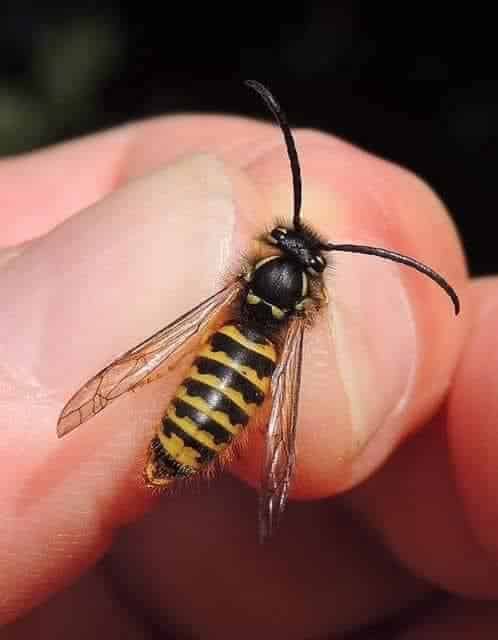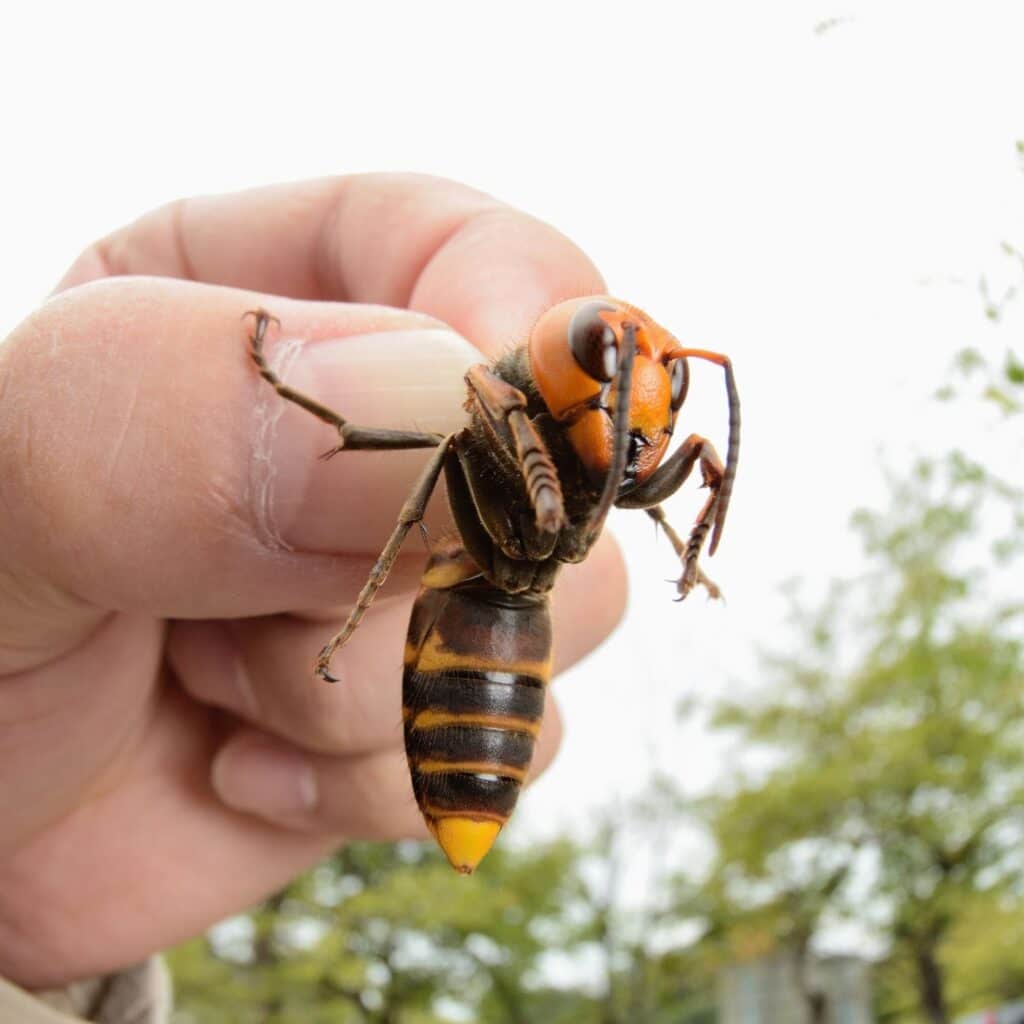A wasp has found their way inside your house, and you are now scared of being stung. On top of that, this annoying insect is buzzing insistently, disturbing your peace. While you may consider letting it out unharmed, that may not work, so why not kill it?
Killing a wasp inside your house offers a permanent solution against it. However, do it carefully and strategically to avoid getting stung.
So, are you looking for effective and safe methods for killing a wasp in your house without getting stung? Worry not; this post provides a comprehensive look into the various ways of achieving this.
How To Kill A Wasp In Your House Without Getting Stung
1. Stay Calm and Avoid Sudden Movements
It’s natural to feel a surge of panic when you see a wasp in your house, but don’t freak out. Remain calm and composed because wasps are highly sensitive to movement and sudden actions, which can trigger their defensive instincts.
By staying calm, you avoid signaling aggression and minimize the chances of being stung. Also, your calm demeanor can influence the wasp’s behavior. If it senses that you are not a threat, it might be more inclined to leave the area on its own.
Related Posts:
So, since panicking is a bad idea, what should you do instead?
Freeze: If you spot a wasp nearby, freeze in place and avoid making any sudden movements or loud noises. Pausing gives you a moment to assess the problem and devise a plan for the next steps.
Back Away Slowly: While remaining still, back away from the wasp. Keep your movements deliberate and slow so you don’t startle the insect. Moreover, maintain a comfortable distance between you and the wasp.
Do Not Swat: The sudden motion of swatting can trigger an attack response, and the wasp might interpret your swat as an aggressive gesture.
2. Identify the Wasp’s Entry and Exit Points
If there’s a wasp inside your house, there has to be a way it is getting inside. In that case, aim to determine whether it is flying toward a specific area or seems to be entering or exiting from a certain location.
Typically, wasps find their way inside through open windows, doors, or gaps around windowsills and doorframes. Therefore, inspect these areas for any openings that might be allowing wasps to enter.
Once you’ve identified possible entry and exit spots, take steps to seal them off. Use caulk or weather stripping to seal gaps around windows and doors. Install mesh screens over vents and chimneys to prevent wasp access.
Furthermore, repair any damaged areas of your home’s exterior that might be entry spotsfor wasps.
3. Open the Exterior Doors and Windows to Give the Wasp An Escape Route
Carefully open the exterior doors and windows closest to the wasp, making sure they are wide enough for the wasp to see and access easily. After that, give the wasp some time to notice the open doors and windows.
Keep in mind that it might take a moment for the wasp to sense the change in airflow and light, indicating an escape route.
Help the wasp navigate easily by ensuring there are no obstacles or barriers between the wasp and the open doors and windows. If the wasp hesitates to fly toward the open doorsor windows, gently encourage it using a long stick, broom, or even a piece of paper, but do not agitate it.
Once the wasp flies out, close the doors/windows behind it to prevent other wasps or insects from entering.
Note
Close the windows and doors to other parts of the house to confine the wasp to one area. This makes dealing with it easier as it ensures the wasp stays in one room.
4. Trap The Wasp With A Glass and Paper
What if guiding the wasp to a door or window isn’t possible, or it is stationary on a surface? Consider trapping it using a glass and a piece of paper. This is an effective and non-aggressive method to capture and safely release a single wasp.
- You’ll need a glass (preferably clear and wide-mouthed) and a piece of stiff paper or thin cardboard, like an index card or a postcard.
- If possible, put on protective clothes, such as long sleeves and pants.
- Slowly approach the wasp, but keep a safe distance.
- Hold the glass using one hand, with the opening facing downwards. Keep the glass steady and aligned with the wasp.
- Gently place the glass’ open end over the wasp without startling it.
- While keeping the glass steady, carefully slide the paper or cardboard piece under the glass, trapping the wasp inside. Ensure the paper opening covers the entire glass.
- Hold the paper in place with one hand while holding the glass with the other hand to create a secure barrier so the wasp can’t escape.
- Lift the glass and paper combination carefully, making sure the wasp remains trapped between them.
- Take the trapped wasp away from the house, then gently tilt the glass and paper combination to allow the wasp to fly away.
5. Create a Distracting Trap
Divert the wasp’s attention from you and towards the exit using a distracting trap. Here’s how to make one.
- Pour a small amount of sweet bait into the small dish or container. Also, consider adding liquid soap and gently mix it in. The soap reduces the surface tension, thus making wasp escape harder once inside.
- Carefully place the dish near the wasp without making any sudden movements. Position the container correctly to encourage the wasp to investigate.
- After placing the trap, step away from the area but keep an eye on the wasp’s movements.
- As the wasp becomes occupied with the bait, gently encourage its movement towards an open window or door. You can use a piece of paper or cardboard to guide its path without getting too close.
6. Use a Wasp-Specific Insect Spray
In the case that distracting techniques aren’t working or the wasp is in a difficult-to-reach area, a wasp-specific insect spray will come in handy. This method will help kill a wasp without risking a stung.
Wasp-specific insect sprays have a long range and can quickly immobilize the wasp. However, use this option as a last resort and be cautious not to spray the insect directly towards yourself or others, as it could agitate the wasp further.
Stand at a safe distance from the wasp when spraying. If you have an extension pole with a spray holder, use it to keep an even greater distance. In addition, shield yourself from accidental contact with the spray by putting on protective clothing, including long sleeves, pants, gloves, closed-toe shoes, and eye protection.
7. Employ Natural Deterrents
Instead of commercial insect sprays, go for a more humane and eco-friendly method of killing a wasp – a natural deterrent. This approach doesn’t kill the wasp but keeps wasps at bay and prevents them from entering your home.
Natural deterrents leverage scents and substances that wasps find unappealing, encouraging them to steer clear of your living space. Some effective repellents to use are vinegar solution, lemongrass oil, peppermint oil, clove oil, cucumber slices, and wasp-repelling plants like eucalyptus, marigold, basil, and spearmint.
8. Use Sticky Traps
With a sticky trap, you can capture and kill a wasp inside your house without being stung. Sticky traps are designed to attract and immobilize insects, including wasps, helping you control their presence indoors.
When buying a sticky trap to kill wasps, choose specifically designed for wasps and flying insects. Once you get the right sticky trap, place it where you’ve noticed wasp activity or where wasps are likely to enter or fly around.
After that, activate the trap. This usually involves removing a protective cover or activating the lure. You can hang your wasp sticky trap or place it on a flat surface.
9. Freeze The Wasp
Another effective way of killing a wasp without getting stung is freezing. Doing so temporarily slows down the wasp’s movements and lowers its activity level, allowing for safer handling. You can opt to use a freezing spray that freezes the wasp upon contact.
Alternatively, capture the wasp inside a container or plastic bag, then put it inside the freezer for 15 to 20 minutes.
10. Wait For Nightfall
Wasps are diurnal insects. Therefore, there’s a higher risk of getting stung by a wasp during the day than at night.
When it gets dark, the wasp is more likely to be sluggish and less aggressive, making it easier to remove without the risk of getting stung. Therefore, consider waiting until nightfall to kill a wasp if you spot them in the evening.
Conclusion
Wasps are beneficial to the ecosystem, but that doesn’t mean you should share your home with them. So, eliminating them is key since their presence can be unsettling. The upside is that you can safely kill a wasp without being stung, stay calm, understand wasp behavior, and employ the right elimination techniques.

I’m Mike Hyle, an exterminator with 7+ years of experience handling all sorts of pests, including mice, cockroaches, bed bugs, and termites. I also write for Pest Solutions DIY blog to share my knowledge and help homeowners keep their homes pest-free. Outside work, I enjoy hunting, snowshoeing, and exploring nature. Check out my blog for helpful pest control tips!


